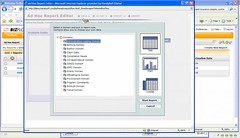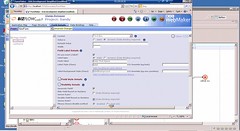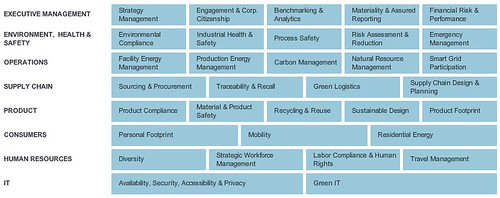Wow, has it really been a month since I last blogged? A couple of weeks vacation, general year-end busyness and a few non-work side projects have kept me quiet, but it’s time to get back at it. I have a few partially-finished product briefings sitting around, and thought it best to get them out before the vendors come out with their next versions and completely obsolesce these posts. 🙂
I had a chat with Garth Knudson of HandySoft in late November about the latest version of their BizFlow product, specifically around the new reporting capabilities and their WebMaker RIA development environment. Although these don’t show off the core BPM capabilities in their product suite (which I reviewed in late 2009), these are two well-integrated tools that allow for easy building of reports and applications within a BizFlow BPM environment. I always enjoy talking with Garth because he says good things about his competitors’ products, which means that not only does he have good manners, but he takes enough care to learn something about the competition rather than just tarring them all with the same brush.
We first looked at their user-driven reporting – available from the My AdHoc Reports option on the BizFlow menu – which is driven by OEM versions of the Jaspersoft open source BI server components; by next year, they’ll have the entire Jaspersoft suite integrated for more complete process analytics capabilities. Although you can already monitor the current processes from the core BizFlow capability, the ad hoc reporting add-on allows users (or more likely, business analysts) to define their own reports, which can then be run on demand or on a schedule.
 If you’ve seen Jaspersoft (or most other ad hoc reporting tools) at work, there isn’t much new here: you can select the data domain from the list of data marts set up by an administrator, then select the type of report/graph, the fields, filtering criteria and layout. It’s a bit too techie for the average user to actually create a new report definition, since it provides a little much close contact with the database, such as displaying the actual SQL field names instead of aliases, but once the definition is created, it’s easy enough to run from the BizFlow interface. Regular report runs can be scheduled to output to a specific folder in a specific format (PDF, Excel, etc.), based on the underlying Jaspersoft functionality.
If you’ve seen Jaspersoft (or most other ad hoc reporting tools) at work, there isn’t much new here: you can select the data domain from the list of data marts set up by an administrator, then select the type of report/graph, the fields, filtering criteria and layout. It’s a bit too techie for the average user to actually create a new report definition, since it provides a little much close contact with the database, such as displaying the actual SQL field names instead of aliases, but once the definition is created, it’s easy enough to run from the BizFlow interface. Regular report runs can be scheduled to output to a specific folder in a specific format (PDF, Excel, etc.), based on the underlying Jaspersoft functionality.
The key integration points with BizFlow BPM, then, are the ability of an administrator to include process instance data in the data marts as well as any other corporate data, allowing for composite reporting across sources; and access to the report definitions in the My AdHoc Reports tab.
The second part of the demo was on their WebMaker application development environment. Most BPM suites these days have some sort of RIA development tool, allowing you to build user forms, screens, portals and dashboards without using a third-party tool. This is driven in part by the former lack of good tools for doing this, and in part by the major analyst reports that state that a BPMS has to have some sort of application development built in to it. Personally, I’m torn on that: most BPMS vendors are not necessarily experts at creating application development tools, and making the BPMS capabilities available for consumption by more generic application development environments through standard component wrappers fits better with a best-of-breed approach that I tend to favor. However, many organizations that buy a BPMS don’t have modern application development tools at all, so the inclusion of at least an adequate one is usually a help.
 HandySoft’s WebMaker is loosely coupled with BizFlow, so it can be used for any web application development, not just BPM-related applications. It does integrate natively with BizFlow, but can also connect with any web service or JDBC-compliant database (as you would expect) and uses the Model-View-Controller (MVC) paradigm. For a process-based application, you define the process map first, then create a new WebMaker project, define a page (form), and connect the page to the process definition. Once that’s done, you can then drag the process variables directly onto the form to create the user interface objects. There’s a full array of on-form objects available, including AJAX partial pages, maps, charts, etc., as well as the usual data entry fields, drop-downs and buttons. Since the process parameters are all available to the form, the form can change its appearance and behavior depending on the process variables, for example, to allow a partial page group to be enabled or disabled based on the specific step in the process or the value of the process instances variables at that step. This allows a single form to be used for multiple steps in a process that require a similar but not identical look and feel, such as a data entry screen and a QA screen; alternatively, multiple forms can be defined and assigned to different steps in the same process.
HandySoft’s WebMaker is loosely coupled with BizFlow, so it can be used for any web application development, not just BPM-related applications. It does integrate natively with BizFlow, but can also connect with any web service or JDBC-compliant database (as you would expect) and uses the Model-View-Controller (MVC) paradigm. For a process-based application, you define the process map first, then create a new WebMaker project, define a page (form), and connect the page to the process definition. Once that’s done, you can then drag the process variables directly onto the form to create the user interface objects. There’s a full array of on-form objects available, including AJAX partial pages, maps, charts, etc., as well as the usual data entry fields, drop-downs and buttons. Since the process parameters are all available to the form, the form can change its appearance and behavior depending on the process variables, for example, to allow a partial page group to be enabled or disabled based on the specific step in the process or the value of the process instances variables at that step. This allows a single form to be used for multiple steps in a process that require a similar but not identical look and feel, such as a data entry screen and a QA screen; alternatively, multiple forms can be defined and assigned to different steps in the same process.
To be clear, WebMaker is not a tool for non-technical people: although a trained business analyst could probably get through the initial screen designs, there is far too much technical detail exposed if you want to do anything except very vanilla static forms; the fact that you can easily expose the MVC execution stack is a clue that this is really a developer tool. It is, however, well-integrated with BizFlow BPM, allowing the process instance variables to be used in WebMaker, and the WebMaker forms to be assigned to each activity using the Process Studio.
HandySoft is one of the small players in the BPMS market, and has focused on ad hoc and dynamic processes from the start. Now that all of the BPMS vendors have jumped into the dynamic BPM fray, it will be interesting to see if these new BizFlow tools round out their suite sufficiently to compete with the bigger players.

